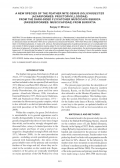A new feather mite species, Dolichodectes sibiricus sp. n. (Pterodectinae), is described from the Dark-sided Flycatcher, Muscicapa sibirica Gmelin, JF, captured on the southern coast of Lake Baikal, Buryatia, Russia. The new species is closest to D. allocaulus (Gaud and Mouchet 1957) and D. platynocercus (Gaud and Mouchet, 1957) from Africa and is distinguished from them in the following features. In males of D. sibiricus, the lateral enlargements of opisthosomal lobes are of a complicated form and consist of distinct angular projections bearing setae f2 and rounded ledges at level of setae h2, and the aedeagus extends to the level of setae ps3; in females, the prodorsal and hysteronotal shields lack ornamentation, the terminal appendages at their bases are 2–2.5 times thicker that setae h2, and setae e2 are situated closer to the level of setae e1 than to the posterior margin of the hysteronotal shield. Brief comments on the systematics of the genus Dolichodectes, a key to the known species, an updated checklist of the world fauna, as well as host associations are provided.
The paper describes a new species, Trouessartia cyane sp. n., collected from the Siberian Blue Robin Larvivora cyane (Pallas) (type host) and the Rufous-tailed Robin L. sibilans Swinhoe in Primorsky Krai (the Russian Far East). The description is supplemented with barcoding data (mitochondrial cytochrome C oxidase subunit I gene).
Trouessartia cyane is closest to T. larvivorae Mironov, 2021 and T. rubecula Jablonska, 1968, differing mainly in measurable characteristics. In particular, in males of T. cyane, the length of terminal lamellae is 20–23 (vs. 25–30 in T. larvivorae and 30–35 in T. rubecula); in females, the length of idiosoma is 515–545 (vs. 555–590 in T. larvivorae and 570–625 in T. rubecula), the distance between setae se is 85–90 (vs. 100–120), the width of opisthosoma at the level of setae h2 is 87–97 (vs. 105–115), setae h1 are thin spiculiform (vs. lanceolate).
Genetic distances within T. cyane, as well as between the new species and four closely related Trouessartia species from four muscicapids distributed in northern Eurasia, have been analyzed using Kimura’s two-parameter (K2P) model. Intraspecific genetic distances within T. cyane varied between 0.006 and 0.01; interspecific distances between the new species and morphologically
close species ranged from 0.154 (T. rubecula) to 0.185 (T. calliope).

